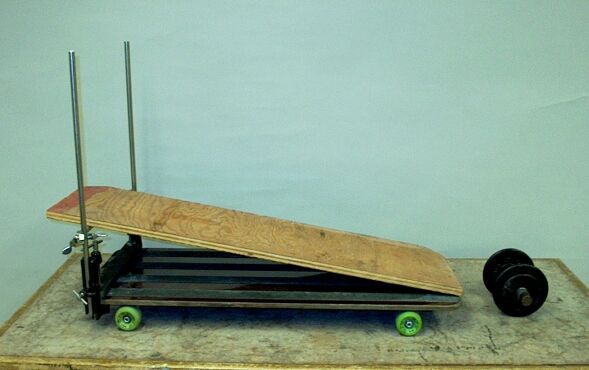
A video of this demonstration (listed as demonstration 24.03) is available at this link.
Place the dumbbell at the top of the ramp, then release it. As gravity accelerates the dumbbell to the right, it also accelerates the skateboard to the left. When the dumbbell rolls off the bottom end of the ramp, it and the skateboard continue in opposite directions at constant velocity (except as they are slowed by friction). Installing a rod across the bottom of the ramp, to stop the dumbell (optional), causes the whole system to come to a stop when the dumbbell reaches the bottom. If you wish, you can adjust the height of the top of the ramp by loosening the clamps that hold the rod that supports it, moving it to the desired height and retightening the clamps. (This demonstration is set up on the floor in front of the main demonstration table. It shown above sitting on a rolling table for purposes of photography.)
The purpose of this demonstration is to illustrate Newton’s third law of motion, which states (as quoted in Resnick, Robert and Halliday, David. Physics, Part 1, Third Edition (New York: John Wiley and Sons, 1977), p. 79) To every action there is always opposed an equal reaction; or, the mutual actions of two bodies upon each other are always equal, and directed to contrary parts. It is similar to demonstration 12.60 -- Roll ball down air cart ramp, in which you roll a steel ball down a ramp that is affixed to an air track glider, and as the ball rolls down the ramp, the glider accelerates in the opposite direction. Except that the dumbbell rolls, and that the skateboard and ramp also roll, this system is similar to a block on an inclined plane (demonstration 12.69 – Slide blocks down incline). In pulling the block downward against the inclined plane, gravity causes the block to exert a force on the plane, which in turn exerts an equal and opposite force on the block. This force has two components, one perpendicular, or normal, to the surface of the plane (= mg cos θ, where m is the mass of the block, and θ is the angle of the incline above horizontal), and one parallel to the plane’s surface (= mg sin θ). Except for friction, the inclined plane cannot exert a force on the block parallel to its surface. The normal force, however, has a horizontal component, (mg cos θ) sin θ, which the block and the plane exert on each other. Instead of a block and an inclined plane, we have a dumbbell and a skateboard ramp, which exert this force on each other. Thus, when you place the dumbbell at the top of the ramp and then release it, as it rolls down the ramp, the skateboard and ramp accelerate in the opposite direction to that of the rolling dumbbell.
If you install the optional stop rod at the bottom of the ramp, then when the dumbbell reaches the bottom, the rod exerts a force on the dumbbell, opposite to its direction of motion, stopping it at the bottom. The dumbbell must exert a similar force on the stop rod in the opposite direction, and the skateboard and ramp also come to a stop.